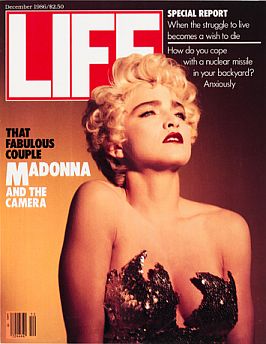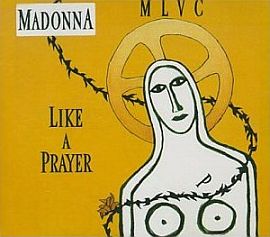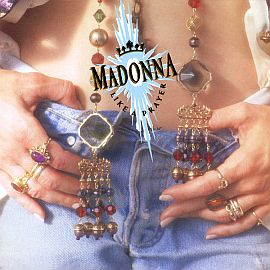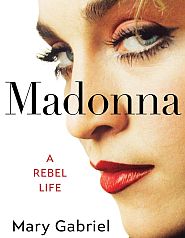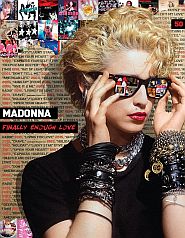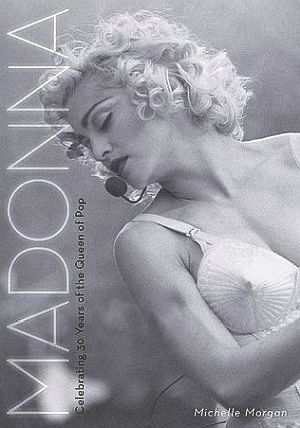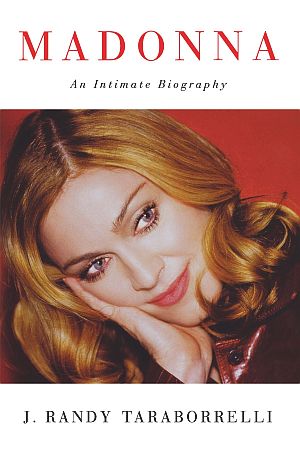In the process, the 60-second TV ad became more of a major film production than a simple soft-drink endorsement. Elaborate performances showcasing the artists and the product of interest were now becoming part of a new commercial persuasion.
In December 1988, Coca-Cola announced that it had signed then popular recording artist George Michael to do some of its TV ads. Shortly thereafter, on January 25th 1989, Pepsi announced they had signed pop sensation Madonna to tout their cola. The deal made front-page business and style-section news across the country. Pepsi would pay Madonna $5 million to appear in a series of TV ads and would also sponsor a Madonna world tour, planned for later that year.
Madonna by this time was already a big star. She had made her 1984 breakthrough performance at the MTV video awards; scored assorted No.1 singles and albums; and had swept up fans around the world. By 1987 she had made the covers of national magazines such as Time, Life and Rolling Stone, and had also begun a film career. But Madonna was also controversial, having stirred the censors on occasion with her lyrics, dress, and/or sexually-suggestive performances. Pepsi was nonetheless happy to have her associate with their product.The TV ad she starred in and helped produce for Pepsi in 1989 — entitled “Make A Wish” — did not appear to be controversial, and in fact was rather wholesome and spirited, tinged with some nostalgia and even family values. It featured her in a song and dance performance centered on her then forthcoming new song “Like A Prayer.” The Pepsi ad used a flash-back storyline opening with Madonna seated in a parlor watching an old black-and-white home movie of herself as a young girl at a birthday party. Pepsi also made an “ad for the ad” — a teaser video to hype the Madonna spot — which ran on national TV at the Grammy awards.The spot cuts back and forth between the young Madonna and adult versions in sync with the lyrics — to various dance scenes, back to the young girl in school, to more dancing in a street scene, back to the girl a little older, another with Madonna dancing among joyful gospel singers, and then finally to Madonna in the opening parlor scene watching the home movie seated with a can of Pepsi. There she watches the little 8-year old Madonna in the black-and-white film at her party, with a 1950s Pepsi bottle and straw, about to blow out the candles on her cake. Across the ages, the two Madonnas toast each other with their respective Pepsis. Then Madonna says to the birthday girl, “Go ahead, make a wish.” With that, the little girl blows out the candles and the film ends. Cut to Pepsi logo and slogan, “A Generation Ahead.” The ad, in fact, comes across quite well, with nothing to offend. Madonna later called it “very, very sweet. It’s very sentimental”– not an inaccurate description.
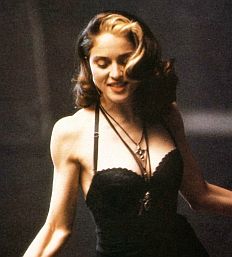
Madonna dancing in Pepsi ad.
No Small Production
The production of this ad was not a casual undertaking. Pepsi and Madonna put a fair amount of time and effort into its casting and choreography. The ad would also be the first time that a major recording was ever released in a TV spot rather than over the radio or other special venue. In fact, Pepsi even made a special “ad for the ad” — a teaser video to hype the ad’s release before it ran. Pepsi ran the teaser spot during the nationally-televised Grammy music awards in February 1989, urging viewers to be sure they saw the forthcoming special Madonna ad. In the teaser, a narrator’s voice runs over a short film clip showing an aboriginal man in a desert making his way to a hut with satellite dish. “No matter where you are in the world on March 2nd,” intones the narrator in theater-shaking surround sound, “get to a T.V. and watch Pepsi’s two-minute Madonna commercial featuring her latest release, ‘Like A Prayer’ [pause] — for the very first time.”Pepsi expected that 250 million people would see the ad’s premiere.
In early March 1989, Pepsi previewed the commercial for the press. The plan was to run the spot around the world on the top-rated evening TV shows in each of some 40 countries. Pepsi expected that 250 million people would see the ad’s premiere. It would begin in Japan and then follow the time zones west around the world through Asia and Europe, finishing in California. Bill Kaatz, an executive with Pepsi’s ad agency, BBDO, said the two-minute ad would later be edited into 60-second and 30-second versions for regular advertising. Everything appeared to be on track. The ad, however, was not what generated the controversy that soon erupted.
“Like A Prayer” Video
In January 1989, Madonna had also made a separate video to help launch her forthcoming new album Like A Prayer, which included the single by that name used in the Pepsi TV ad. This video, however, had much different imagery than the Pepsi ad. It was much more avant-garde in its composition, some might say.
In the video, the action begins with Madonna running from the sound of police sirens, falling to the ground and then entering a church for sanctuary. In flashback sequences, it is shown that Madonna has witnessed a rape and stabbing of a woman by a white man. The rape victim is aided by a black man who is then blamed for the crime and arrested. Meanwhile, inside the church, Madonna is shown in scenes seeking what appears to be a kind of prayerful guidance about her dilemma as the witness to the crime for the wrongly-accused Good Samaritan black man. In the church, she also appears to be quite taken with a statue of the black saint, possibly Saint Martin de Porres, who resembles the Good Samaritan black man she has seen on the street.
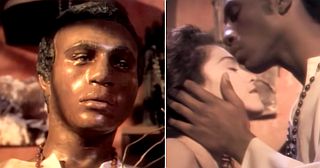
In the “Like a Prayer” video, a statue of a black saint, resembling a wrongly-accused black man, comes alive.
There is also a dream sequence in the video after Madonna has laid down in a pew, along with other scenes of Madonna dancing and singing in front of burning KKK-type crosses, as well as dancing and singing with a gospel choir in the church. But finally, she is shown going to the police station as a witness, helping to free the innocent black man. At the end of the video, a curtain comes down, and Madonna and cast come out on stage to take a bow.
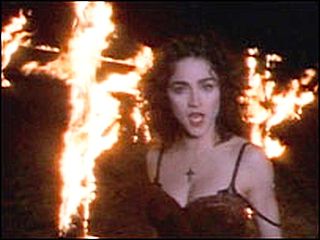
Madonna’s “Like A Prayer” video ran in “heavy rotation” on MTV during March 1989. Click for full video at YouTube.
However, in its day back in 1989, the “Like a Prayer” video began running on cable TV’s MTV channel on March 3rd, 1989, the day after the Pepsi TV commercial aired. The Pepsi spot had run on March 2nd without incident on the family-oriented Cosby Show and also in other locations around the world. An estimated 250 million people saw the first airing in the U.S., the U.K., and other countries. Meanwhile, the “Like A Prayer” video on MTV ran in what is called “heavy rotation,” as was then the normal practice at the channel with popular music. And that’s when the trouble began for Pepsi.
Boycott Threatened
The first objections came from Rev. Donald Wildmond of the American Family Association, a Christian group. Wildmond threatened to have his AFA Journal’s 380,000 subscribers boycott Pepsi until the company bowed to his demands. From his home base in Tupelo, Mississippi, Wildmond demanded that Pepsi nullify their deal with Madonna Religious groups charged Madonna with “ridiculing Christianity,” and bid Pepsi to drop their deal with her.because their commercial is “putting Madonna up as a clean, wholesome role model” on the one hand, while her MTV video on the other hand was “ridiculing Christianity.” Wildmond was no novice to these kinds of fights, as he had recently boycotted Martin Scorsese’s film The Last Temptation of Christ. Pepsi, however, had not seen Madonna’s MTV video before their own TV ad began to run, nor did they have the right to make any judgements about Madonna’s other work
Initially, when Wildmond’s boycott threat arose, Pepsi spokesman Tod McKenzie tried to deflect the negative press. “Why isn’t he going after the [MTV] video?” McKenzie asked. “Why has he targeted really an innocent, wholesome commercial people have responded favorably to?” Still, Pepsi immediately put a hold on further broadcasting of the Madonna ad until they could assess what was happening. Then a Catholic bishop from Texas, Rene Gracido, added his voice to the fight, calling Madonna’s video offensive. He too called for a boycott of Pepsi and its other businesses — Taco Bell, Pizza Hut, and Kentucky Fried Chicken. The protest began to grow. Some Catholic groups in Italy started to protest. Then came a giant blow: the Pope released a statement by the Vatican that banned Madonna from appearing in Italy. The album Like a Prayer was later censured by the Vatican.
Hot Potato
“I really couldn’t believe how out of control the whole Pepsi thing got.”
– MadonnaPepsi dropped Madonna like a hot potato and the ad was never shown again. Said a Pepsi spokesman at the time: “When you’ve got an ad that confuses people or concerns people, it just makes sense that that ad goes away.” Still, the ad survives today on You Tube and other web sites (see links above). Pepsi also dropped its planned sponsorship of Madonna’s world tour, although some Madonna Pepsi cans had already been printed. Madonna, however, retained her entire $5 million payment even though her contract had called for three more Pepsi commercials. Madonna, meanwhile, professed surprise at the reaction. “When I think of controversy, I never really think people are going to be half as shocked as they are at what I do,” she said. “I really couldn’t believe how out of control the whole Pepsi thing got.”
Soaring Record Sales
The controversy, however, did not appear to hurt Madonna’s music sales or slow her rising star. The news coverage and the controversy simply bolstered her cache. The timing of the whole affair was very good indeed — coming just as some 2 million copies of her album Like A Prayer were heading for the record stores.
By late March and early April 1989, the single and the album, Like a Prayer, both shot to No.1 on the Billboard charts. The album would proceed to sell 13 million copies worldwide, 4 million alone in the U.S., also spawning four Top Ten singles and becoming the top album in over thirty countries.
“If there was anyone left in the world who didn’t know who Madonna was up until that point,” wrote Mark Bego in his 1992 book, Madonna: Blonde Ambition, “they certainly knew who she was now.” Still, at this point, Madonna had another two decades of career and controversy ahead, with many more albums, movies, concerts and multi-million-dollar contracts to come. By January 2007, Forbes magazine was reporting that Madonna was the 4th wealthiest woman in entertainment, worth an estimated $350-to-$400 million dollars.
For additional stories on celebrity advertising at this website please see the “Madison Avenue” category page. Other stories on famous women can be found on the “Noteworthy Ladies” topics page. Thanks for visiting – and if you like what you find here, please make a donation to help support the research and writing at this website. Thank you. – Jack Doyle.
|
Please Support Thank You |
_______________________________
Date Posted: 25 April 2008
Last Update: 30 January 2024
Comments to: jackdoyle47@gmail.com
Article Citation:
Jack Doyle, “Madonna’s Pepsi Ad, 1989,”
PopHistoryDig.com, April 25, 2008.
_____________________________
Books & Film at Amazon.com…
Sources, Links & Additional Information
Michael J. McCarthy, “Soda War Goes Pop, as Pepsi Signs Madonna,” Wall Street Journal, January 26 , 1989, p. B-1.
Paul Farhi, “Pepsi Puts Some Fizz in Its Ads: Madonna Signs Up With No. 2 Soft Drink,” Washington Post, Jan 26, 1989, p.E-1.
Andrea Adelson, “Madonna Joins Pepsi Lineup,” New York Times, Jan 26, 1989.
Jane Applegate, “Pepsi Recruits Madonna to Help Fight Cola War,” Los Angeles Times, January 26, 1989, Section IV, p.1.
Peter Fearon, “Stars Win Stripes in the Cola Wars,” Media & Marketing, The Times (London), Wednesday, February 8, 1989.
“Going Global with Madonna — Pepsi-Cola Co.’s Commercial To Air in 40 Countries,” New York Times, March 2, 1989, p. C-16.
Joanne Lipman, “Debut of Madonna Single; ‘Like a Prayer’ Song to Make Debut on Pepsi Television Commercial,” Wall Street Journal, March 2 , 1989, p. B-6.
Michael J. McCarthy, “Christian Group Says It Will Boycott Pepsi Over Madonna Ties; Association Led By Wildmon Calls New Music Video By Rock Singer Offensive,” Wall Street Journal, March 9, 1989, p. B-7.
“Another Temptation,” U.S. News & World Report, March 20, 1989, p.13.
Bill Zehme, “Madonna – Rolling Stone Interview,” Rolling Stone, March 23, 1989, p.50.
“Pepsi Cancels Madonna Ad,” New York Times, April 5, 1989.
James R. Schiffman, “Pepsico Cans TV Ads With Madonna, Pointing up Risks of Using Superstars,” Wall Street Journal, April 5 , 1989, p. B-11.
Bruce Horovitz, “Attempt To Cap Madonna Ad Protest Fizzles For Pepsi,” Los Angeles Times, April 7, 1989, p. IV-3.
Peter Waldman, “This Madonna Isn’t What the Reverend Really Had in Mind; Minister Helped Get Pepsi to End Singer’s Racy Ad: He Pans ‘Lonesome Dove,'”Wall Street Journal, April 7, 1989, p. A-1.
“Headliners; Quick Cancellation,” New York Times, April 9, 1989.
Dody Tsiantar, “Turning Out TV Ads; Pepsi Pulls its Too-Hot-to-Handle Madonna Spot as a New Study Asks Who’s Really Paying Attention,” Newsweek, April 17, 1989, p. 42.
“Madonna’s ‘Like a Prayer’ Clip Causes a Controversy,” Rolling Stone, April 20, 1989, p. 22.
Bruce Horovitz, “Pepsi Plans No New Ads to Sub for Pulled Madonna TV Spot,” Los Angeles Times, April 20, 1989, p. IV-3.
Jeffrey Ressner, “Pepsi Goes Flat on Madonna,”Rolling Stone, May 18, 1989, p. 27.
“Madonna (entertainer),” Wikipedia.org.
Mark Bego, “The Madonna/Pepsi Controversy,” in Madonna: Blonde Ambition ,New York: Cooper Square Press, 1992.
_____________________________________
